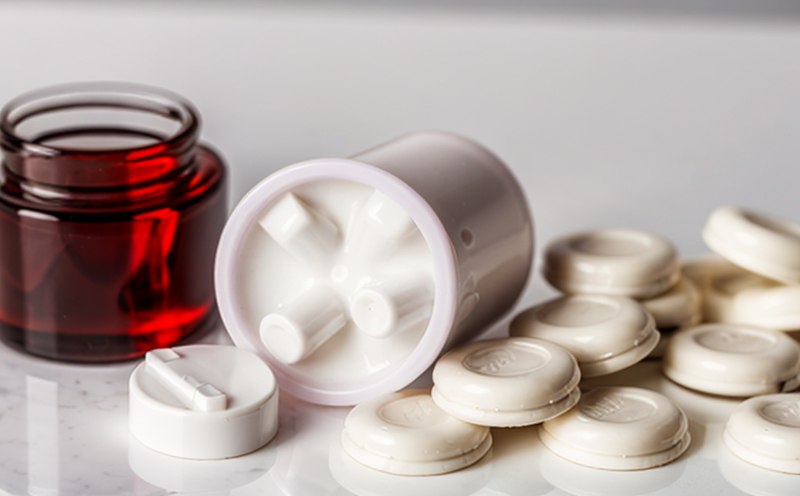USP Identification by HPLC Testing
The United States Pharmacopeial Convention (USP) Identification Tests are critical in ensuring pharmaceutical products meet high standards of quality and consistency. USP Identification by High-Performance Liquid Chromatography (HPLC) is a robust analytical technique used to identify drug substances or excipients present in oral solid dosage forms, such as tablets or capsules.
This testing method relies on the unique retention times and peak characteristics that are specific to each substance. The process involves dissolving the test sample in an appropriate solvent, then injecting this solution into the HPLC system where it is separated based on its interaction with the stationary phase of the column. Once separation is complete, a detector records the absorbance or refractive index changes at various wavelengths or refractive indices, creating a chromatogram.
The resulting chromatogram allows for precise identification when compared to reference standards. This method provides accurate and reproducible results that are essential in pharmaceutical quality assurance and regulatory compliance.
In an oral solid dosage form, the testing process begins with proper sampling techniques which ensure that representative samples are collected from various parts of the batch or unit. After thorough sample preparation, including drying and grinding if necessary, the substance is dissolved using a suitable solvent compatible with HPLC analysis.
The chromatographic column used in this test plays a crucial role as it determines how well individual components separate based on their physicochemical properties. Common types include reversed-phase, ion-exchange, or normal-phase columns depending upon the nature of compounds being analyzed. Proper choice ensures optimal separation and resolution critical for accurate identification.
Following injection into the HPLC system, detection occurs at specific wavelengths or refractive indices corresponding to the substance under examination. For instance, ultraviolet (UV) detection is often employed when dealing with aromatic or conjugated systems whereas refractive index detectors prove useful for polar compounds like sugars or amino acids.
The final step involves comparing the obtained chromatogram against known reference standards provided by USP or other authoritative sources. This comparison helps establish whether the sample contains any impurities, degradation products, or related substances that could affect its safety and efficacy.
- Proper sampling: Ensures accurate representation of the batch/sample.
- Sample preparation: Includes appropriate dissolution techniques tailored to different dosage forms.
- Column selection: Critical for effective separation of components based on their characteristics.
- Detection methods: UV and refractive index detection are common but may vary depending upon the compound being analyzed.
This detailed approach guarantees reliable identification, thereby supporting the integrity of pharmaceutical products through rigorous quality control measures.
Why Choose This Test
The USP Identification by HPLC Testing is a cornerstone in ensuring the authenticity and purity of active ingredients within oral solid dosage forms. Pharmaceutical manufacturers rely on this method because it offers several key advantages:
- Precision and Accuracy: HPLC provides precise quantification and characterization of components, which is vital for maintaining product consistency.
- Regulatory Compliance: By adhering to USP standards, companies demonstrate their commitment to regulatory requirements set forth by governing bodies like the FDA.
- Quality Assurance: Identifying impurities early in the production process allows for swift corrective actions, enhancing overall product quality.
- Patient Safety: Ensuring accurate identification reduces risks associated with counterfeit drugs or those containing harmful contaminants.
These benefits make USP Identification by HPLC a preferred choice among pharmaceutical firms seeking to uphold the highest standards of integrity and safety in their products.
Customer Impact and Satisfaction
- Trust: Customers gain confidence knowing that rigorous testing has been conducted.
- Health: Ensures safer drug use by eliminating potentially harmful substances.
- Efficiency: Simplifies compliance with regulatory guidelines, reducing operational costs.
In summary, this test not only upholds the integrity of pharmaceutical products but also enhances customer trust and satisfaction while ensuring stringent adherence to regulatory standards.
International Acceptance and Recognition
The USP Identification by HPLC Testing is widely recognized across international borders due to its rigorous methodology and strict adherence to global standards. Many countries adopt these methods as part of their national pharmacopeias, reflecting the universal acceptance and reliability they offer.
For instance, the European Pharmacopoeia (PhEur) and Japanese Pharmacopoeia (JP) also incorporate similar identification tests based on HPLC principles. This harmonization fosters greater consistency in quality assurance practices worldwide.
The International Organization for Standardization (ISO) has published standards related to chromatographic techniques, further validating the accuracy and precision of such methods. Compliance with these international guidelines ensures that pharmaceutical products meet acceptable quality levels wherever they are distributed.
Moreover, acceptance by regulatory authorities like the FDA in the United States underscores its importance globally. Pharmaceutical companies aiming for worldwide distribution benefit significantly from consistent testing methodologies that satisfy multiple jurisdictions simultaneously.





